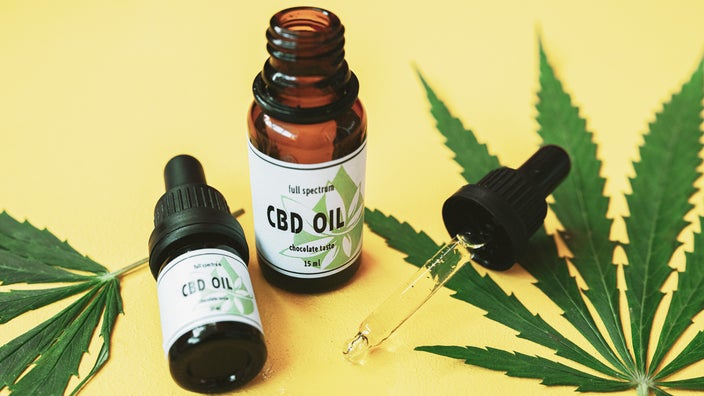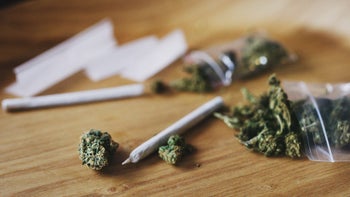
5 Tips for Buying the Best Over-the-Counter CBD Products
Key takeaways:
There are many CBD products on the market, but not all of them are high quality. Contaminants and inaccurate labeling is common, since CBD products sold over the counter aren’t regulated by the FDA.
Look for third-party testing and make sure the ingredients, dosage, and expiration date are on the label. The lot number and the manufacturer’s contact information should be on the container as well.
It’s best to purchase CBD products from a pharmacy, state-regulated dispensary, or a trusted manufacturer. Beware of online marketplaces and websites that don’t have detailed testing information available about their CBD products.
Table of contents

Cannabidiol (CBD) is a cannabinoid, an active ingredient found in the cannabis plant. It’s sold over the counter (OTC) in a wide variety of products, such as gummies, beverages, and topical creams. People turn to CBD to help with symptoms such as pain, stress, and anxiety.
Unlike tetrahydrocannabinol (THC), CBD isn’t intoxicating and won’t make you feel “high" — but that doesn’t mean it’s safe for everyone. What’s more, the safety and purity of CBD products isn’t regulated by the FDA.
So what’s the best way to find safe, high-quality CBD? We provide 5 tips for finding the best CBD products below.
Search and compare options
1. Understand the risks
As mentioned, OTC CBD products aren’t well regulated. This is an issue for several reasons, including:
Inaccurate product strength: One of the biggest issues with CBD products is that it’s common for them to contain less or more CBD than the label indicates. This can make dosing a challenge, and raise your risk of side effects or drug interactions.
Risk of Contaminants: The cannabis plant absorbs heavy metals and other toxins from the soil as it grows. Mold and pesticides can also be present. These contaminants can end up in the final CBD product if it isn’t processed properly and cause serious health risks if they’re consumed.
Unknown ingredients: Since testing isn’t required for CBD products, it’s possible they may contain other ingredients that aren’t listed on the bottle. This includes THC as well as synthetic (lab-made) cannabinoids with unknown safety.
Understanding what’s at stake when you purchase low-quality CBD products can help guide you when it comes to choosing a reliable product.
2. Know about the different types of CBD and how they differ
There are three main types of CBD found in OTC products:
Full-spectrum CBD: These products contain CBD along with other compounds from the cannabis plant, including terpenes, flavonoids, and other cannabinoids (such as THC). But legally, they can only contain up to 0.3% THC in order to be sold OTC.
Broad-spectrum CBD: These products have removed THC. But they may contain other cannabinoids, such as cannabinol (CBN) or cannabigerol (CBG) as well as terpenes and flavonoids.
CBD isolate: This is the purest form of CBD. It does not contain any additional cannabinoids or terpenes. CBD isolate is often lab-made rather than extracted from the cannabis plant.
Since full-spectrum CBD products contain some THC, they may cause a positive drug test. But full and broad-spectrum products may have additional benefits over products that only contain CBD isolate, since they contain other compounds along with CBD.
Read more like this
Explore these related articles, suggested for readers like you.
3. Shop at reputable places
As with any OTC supplement, you should only purchase CBD from reliable sources. Avoid purchasing CBD products at gas stations, smoke shops, or third-party online retailers.
In most cases, the CBD products sold by pharmacies, state-licensed cannabis dispensaries, and medical offices have been evaluated to make sure they’re high quality. Supplement retailers and manufacturer websites require a bit more leg-work to determine if the available CBD products are worth trying.
Keep in mind that CBD products may not be available in certain states. And each state has different regulations for what types of CBD products can be sold and where you can purchase them. So you can also check your state government’s website for information to help you find and purchase legal CBD products if they’re available.
4. Look for third-party testing and proper labeling
Most reliable CBD companies will use an independent (third-party) lab to test their products. The lab then provides a certificate of analysis that lists the active ingredients as well as any contaminants detected in the product.
These lab results should be available on the manufacturer’s website or through a QR code on the package. If third-party lab results aren’t available, you shouldn’t purchase the product.
The package labeling of a high-quality CBD product should also contain certain information, including:
Name and address of the manufacturer
Active Ingredients
Inactive ingredients
Quantity (weight)
Lot, batch, or control number
Production date
Expiration date
Storage instructions
Serving size and dosing information
Warnings/contradictions
These items help you know how to use the product safely and who to contact with any questions or concerns. If any of the above information is missing from the product label, it’s best to avoid the item.
5. Talk to a healthcare professional
It’s easy to purchase CBD products OTC, so you may not think about talking to a healthcare professional about it. But CBD has side effects and interactions to consider before taking it. Plus, it may not be safe if you are pregnant or have certain health conditions, such as liver problems.
What’s more, CBD comes in several different dosage forms, from gummies and oils you place under the tongue to vape pens and topical creams. Each type of CBD works differently, and has different risks and benefits to consider. The type of CBD and what dosage to try is something your healthcare team can help you determine based on your personal medical history.
The bottom line
There are many CBD products on the market, but not all of them are created equal. Contaminants and inaccurate labeling are common in over-the-counter (OTC) CBD products. And since the FDA doesn’t regulate them, you’ll need to know what to look for in order to protect your safety.
When you shop for OTC CBD products, look for third-party test results and clear labels that include information on dosing, expiration, and the manufacturer’s contact information. Only purchase CBD products from a pharmacy, state-regulated dispensary, or trusted manufacturer. And talk to your healthcare team to make sure it’s safe before you take it.
Why trust our experts?


References
Americans for Safe Access. (2019). Patient’s guide to CBD.
Cather, J. C., et al. (2020). Cannabidiol primer for healthcare professionals. Proceedings.
Evans, D. G. (2020). Medical fraud, mislabeling, contamination: All common in CBD products. Missouri Medicine.
Johnson, E., et al. (2022). Label accuracy of unregulated cannabidiol (CBD) products: Measured concentration vs. label claim. Journal of Cannabis Research.
Laurence, E., et al. (2023). Your guide to CBD legalization by state. Forbes Health.
MacCallum, C. A., et al. (2023). A clinical framework for evaluating cannabis product quality and safety. Cannabis and Cannabinoid Research.
Montoya, Z., et al. (2020). Cannabis contaminants limit pharmacological use of cannabidiol. Frontiers in Pharmacology.
National Conference of State Legislatures. (2023). State medical cannabis laws.
U.S. Food and Drug Administration. (2024). FDA regulation of cannabis and cannabis-derived products, including cannabidiol (CBD).
Vida, R. G., et al. (2023). Safety and risks of CBD oils purchased online: Unveiling uncertain quality and vague health claims. Frontiers in Pharmacology.
Keep in mind that cannabinoids are legal in some states for personal and/or medicinal use, but not in others. Certain cannabinoids are still illegal under federal law.





























